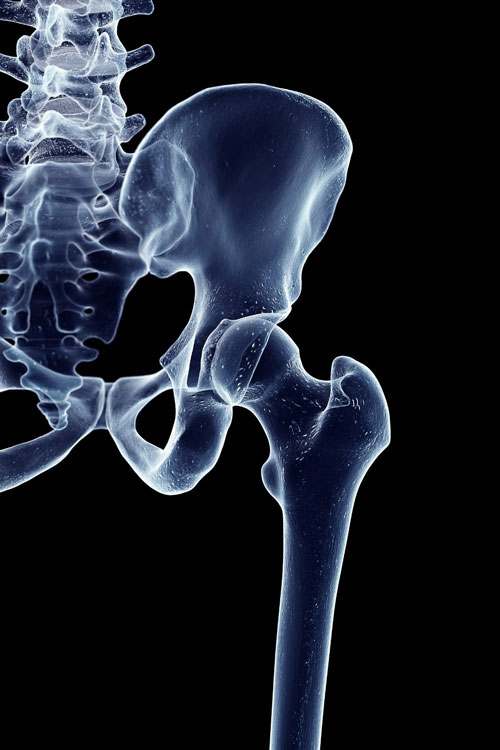
Daily Movements for Healthy Hips
If you enjoy walking, running, cycling, dancing, or any number of other physical activities that rely on your lower body, then having well-functioning hips is a must.
It’s easy to imagine how less-than-optimal hip function could negatively impact activities of this nature. However, even something as simple as reaching for a doorknob or turning to quickly look over your shoulder is reliant on high levels of control and strength at the hips.
What’s happening inside your hip?
Your hip is a complex joint that joins the rounded ‘ball’ of bone at the upper end of your thighbone (or ‘femur’) with the socket (or ‘acetabulum’) at the bottom of your pelvis.

Your hip is a ‘ball and socket’ joint, where the ball-shaped head of the femur bone fits into the socket, or ‘acetabulum’.
Criss-cross bands of tissue called ligaments hold the joint together. These slightly elastic ropes of connective tissue help to stabilize your hip, preventing the bones from moving too far from where they should be.
In addition to bones and ligaments, there’s also a host of other tissues influencing your hip such as muscles, tendons, cartilage, blood vessels and nerves. More than 20 muscles cross the hip and are situated all around the joint in order to contribute to movement in multiple directions.
What does your hip do?
As the largest weight-bearing joint in the body, your hip is designed to perform a number of different actions:
- Forwards and backwards (flexion and extension), as in walking.
- Sideways (abduction and adduction), as in side-stepping.
- Circular (circumduction), as if you were drawing circles with your leg.
- Rotational, such as turning your leg inwards and outwards from your hip.
Compensating for poor hip function
With so many components contributing to the structure and function of your hip, it’s easy to see why maintaining smoothly operating hips is important. Tightness at one group of muscles (such as those that flex your hip) can lead to weakness at another (such as the muscles that extend your hip).
Additionally, if we lose the ability to move well at any joint, others will be forced to compensate.
An example of this is the link between restricted hip range-of-motion (ROM) and various conditions such as low back pain, which is well documented in both elite athletic and non-athletic individuals. It is believed that limited hip ROM creates excessive load and stress on other joints (such as the low back and pelvis), eventually leading to pain in that area.
Repetitive patterns and static postures (such as sitting for prolonged periods) are understood to reduce the strength and ROM of your hips. The trend towards the sedentary lifestyles of recent years has been compounded by the rise of work-from-home arrangements. With more people spending an ever-increasing amount of time in front of computers and devices, we’re sitting longer and exploring the capacity of our hips less.
Movements for happy hips
As the saying goes, an ounce of prevention is worth a pound of cure. Rather than waiting until you experience pain or dysfunction in your hips, pre-emptively implementing some regular bodyweight movements can be a great way to maintain or improve function.
Check out this Flow from Australian Master Instructor, Alisha Smith, as she demonstrates a sequence of movements that is bound to keep your hips happy. You can find tutorials for each movement at Animal Flow On Demand. Not a subscriber? Not a problem! Start your free 14-day trial and get full access to over 100 tutorials plus Flows, classes and more.
Healthy Hips Flow
Set Ape
Left Lateral Traveling Ape Version 3 into left leg Front Step
Set Loaded Beast
Left leg Scorpion Reach
Left leg Underswitch to right arm Crab Reach
Return to Crab into left leg Underswitch to Ape
Right Lateral Traveling Ape Version 3 into right leg Front Step
Set Loaded Beast
Right leg Scorpion Reach
Right leg Underswith to left arm Crab Reach
Return to Crab into right leg Underswitch to Ape
It’s not only your hips that can benefit from incorporating some ground-based movement into your day. Find out more about how Animal Flow can aid your neck and back.
